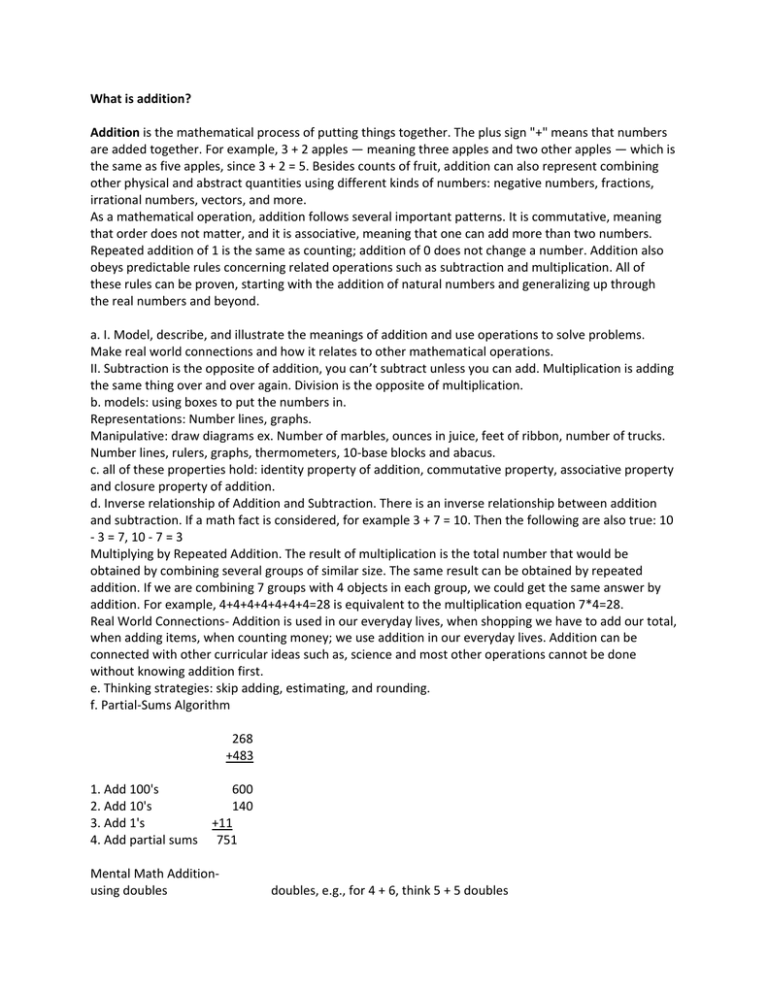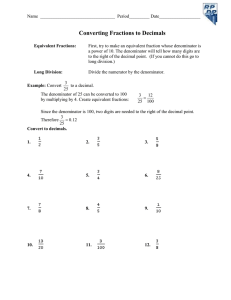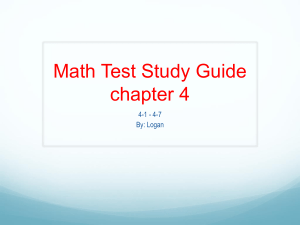What is addition? - Westminster College
advertisement

What is addition? Addition is the mathematical process of putting things together. The plus sign "+" means that numbers are added together. For example, 3 + 2 apples — meaning three apples and two other apples — which is the same as five apples, since 3 + 2 = 5. Besides counts of fruit, addition can also represent combining other physical and abstract quantities using different kinds of numbers: negative numbers, fractions, irrational numbers, vectors, and more. As a mathematical operation, addition follows several important patterns. It is commutative, meaning that order does not matter, and it is associative, meaning that one can add more than two numbers. Repeated addition of 1 is the same as counting; addition of 0 does not change a number. Addition also obeys predictable rules concerning related operations such as subtraction and multiplication. All of these rules can be proven, starting with the addition of natural numbers and generalizing up through the real numbers and beyond. a. I. Model, describe, and illustrate the meanings of addition and use operations to solve problems. Make real world connections and how it relates to other mathematical operations. II. Subtraction is the opposite of addition, you can’t subtract unless you can add. Multiplication is adding the same thing over and over again. Division is the opposite of multiplication. b. models: using boxes to put the numbers in. Representations: Number lines, graphs. Manipulative: draw diagrams ex. Number of marbles, ounces in juice, feet of ribbon, number of trucks. Number lines, rulers, graphs, thermometers, 10-base blocks and abacus. c. all of these properties hold: identity property of addition, commutative property, associative property and closure property of addition. d. Inverse relationship of Addition and Subtraction. There is an inverse relationship between addition and subtraction. If a math fact is considered, for example 3 + 7 = 10. Then the following are also true: 10 - 3 = 7, 10 - 7 = 3 Multiplying by Repeated Addition. The result of multiplication is the total number that would be obtained by combining several groups of similar size. The same result can be obtained by repeated addition. If we are combining 7 groups with 4 objects in each group, we could get the same answer by addition. For example, 4+4+4+4+4+4+4=28 is equivalent to the multiplication equation 7*4=28. Real World Connections- Addition is used in our everyday lives, when shopping we have to add our total, when adding items, when counting money; we use addition in our everyday lives. Addition can be connected with other curricular ideas such as, science and most other operations cannot be done without knowing addition first. e. Thinking strategies: skip adding, estimating, and rounding. f. Partial-Sums Algorithm 268 +483 1. Add 100's 2. Add 10's 3. Add 1's 4. Add partial sums 600 140 +11 751 Mental Math Additionusing doubles doubles, e.g., for 4 + 6, think 5 + 5 doubles making 10 one more, one less making 10, e.g., for 7 + 5, think 7 + 3 + 2 doubles take away one, e.g., for 4 + 5, think 5 + 5 – 1 Standard Addition- 4 + 0 = 4, 4 + 3 = 7, 3 + 2 = 5 344 +230 574 h. Common student errors: not adding the numbers correctly, the child might line up the numbers incorrectly. I. language and symbols: Addition, +, combining, sum, greater than, addend, equal or equivalent Addition facts: When you add two numbers together you find how many you have in all. The addition facts for 0, through 9 are in the following table. ZERO 0+0=0 0+1=1 0+2=2 0+3=3 0+4=4 0+5=5 0+6=6 0+7=7 0+8=8 0+9=9 1+0=1 1+1=2 1+2=3 1+3=4 1+4=5 1+5=6 1+6=7 1+7=8 1+8=9 1+9=10 2+0=2 2+1=3 2+2=4 2+3=5 2+4=6 2+5=7 2+6=8 2+7=9 2+8=10 2+9=11 3+0=3 3+1=4 3+2=5 3+3=6 3+4=7 3+5=8 3+6=9 3+7=10 3+8=11 3+9=12 4+0=4 4+1=5 4+2=6 4+3=7 4+4=8 4+5=9 4+6=10 4+7=11 4+8=12 4+9=13 5+0=5 5+1=6 5+2=7 5+3=8 5+4=9 5+5=10 5+6=11 5+7=12 5+8=13 5+9=14 6+1=7 6+2=8 6+3=9 6+4=10 ONE TWO THREE FOUR FIVE SIX 6+0=6 6+5=11 6+6=12 6+7=13 6+8=14 6+9=15 7+0=7 7+1=8 7+2=9 7+3=10 7+4=11 7+5=12 7+6=13 7+7=14 7+8=15 7+9=16 8+0=8 8+1=9 8+2=10 8+3=11 8+4=12 8+5=13 8+6=14 8+7=15 8+8=16 8+9=17 9+0=9 9+1=10 9+2=11 9+3=12 9+4=13 9+5=14 9+6=15 9+7=16 9+8=17 9+9=18 10+0=10 10+1=11 10+2=12 10+3=13 10+4=14 10+5=15 10+6=16 10+7=17 10+8=18 10+9=19 SEVEN EIGHT NINE TEN 10+10=20 Adding Numbers Arranged Vertically How to add two two-digit numbers (for example 29 + 33). If the numbers are arranged vertically, they are in a format ready to be added. 29 33 Add the ones' place digits (9 + 3 = 12). This sum is a two-digit number, so place a one above the tens' place column and place the two below the line in the ones' place column. 1 29 33 2 Add the tens' place digits (1 + 2 + 3 = 6) and place the answer below the line in the tens' place column. 29 33 62 Addition of Decimals Decimals are fractional numbers. The decimal 0.3 is the same as the fraction 3/10. The number 0.78 is a decimal that represents 78/100. Adding Decimals is just like adding other numbers. Always line up the decimal points when adding decimals. Remember to put the decimal point in the proper place in your answer. Adding Money Amounts Amounts of money may be written in several different ways. Cents may be written with the ¢ sign and dollars can be written with the dollar sign ($). Adding money that is expressed in these forms just involves adding the amounts and placing the proper sign on the answer. Often money is written as a decimal with dollars to the left of the decimal point and cents to the right of the decimal point. Twenty-three dollars and eighty-seven cents is written $23.87. Decimal money amounts are added the same way that decimals are added. Remember to put the $ sign before the answer. Adding Decimals is just like adding other numbers. Always line up the decimal points when adding decimals. Remember to put the decimal point in the proper place in your answer. Adding Feet and Inches How to add Feet and Inches Add the inches together. If the number of inches is greater than 12, divide the inches by 12. The quotient is the number of feet that need to be added to the other feet. The remainder is the number of extra inches. Add the original feet plus the whole feet resulting from the addition of the inches. Example: Add 5 feet 8 inches plus 3 feet 10 inches Add 8 inches to 10 inches: 8 + 10 = 18 inches The number of inches is greater than 12 so divide by 12: 18 ÷ 12 = 1 foot 6 inches Add the Feet: 5 + 3 + 1 = 9 feet Adding Pounds and Ounces How to add pounds and ounces Add the ounces together. If the number of ounces is greater than 16, divide the ounces by 16. The quotient is the number of pounds that need to be added to the other pounds. The remainder is the number of extra ounces. Add the original pounds plus the whole pounds resulting from the addition of the ounces. Adding Tens How to add two-digit numbers (for example 40 + 50). Place one number above the other so the tens' place digits and ones' place digits are lined up. Draw a line under the bottom number. 40 50 90 Adding Three One-Digit Numbers Adding three numbers (for example 5 + 8 + 7) involves two steps. Mentally add the first two numbers. (5 + 8 = 13). Add the other number to this sum. (13 + 7 = 20). Adding Hundreds How to add three-digit numbers (for example 600 + 500). Place one number above the other so the hundreds' place digits, the tens' place digits and ones' place digits are lined up. Draw a line under the bottom number. 600 500 Add the two ones' place digits. (0 + 0 = 0). 600 500 0 Add the numbers in the tens' place column (0 + 0 = 0) and place the answer below the line and to the left of the ones' place sum. 600 500 00 Add the numbers in the hundreds' place column (6 + 5 = 11) and place the answer below the line and to the left of the tens' place sum. 600 500 1100 Properties of Addition There are four mathematical properties which involve addition. The properties are the commutative, associative, additive identity and distributive properties. Commutative property: When two numbers are added, the sum is the same regardless of the order of the addends. For example 4 + 2 = 2 + 4 Associative Property: When three or more numbers are added, the sum is the same regardless of the grouping of the addends. For example (2 + 3) + 4 = 2 + (3 + 4) Additive Identity Property: The sum of any number and zero is the original number. For example 5 + 0 = 5. Distributive property: The sum of two numbers times a third number is equal to the sum of each addend times the third number. For example 4 * (6 + 3) = 4*6 + 4*3 Place Values - Expanded Form Each digit of a number, such as 495,786, has a different place value name. 4 9 5,7 8 6 | | | | | |__ digits' place value | | | | |____ tens' place value | | | |______ hundreds' place value | | |________ thousands' place value | |__________ ten-thousands' place value |____________ hundred-thousands' place value There are 4 sets of one hundred thousand, 9 sets of ten thousand, 5 sets of one thousand, 7 sets of one hundred, 8 sets of ten, and 6 ones in the number 495,786. Expanded form shows the number expanded into an addition statement. The expanded form of 495,786 is 400,000 + 90,000 + 5,000 + 700 + 80 + 6. Estimating a sum by rounding A quick way to estimate the sum of two numbers is to round each number and then add the rounded numbers. It is likely that this won't be the exact answer but it may be close enough for some purposes. How to Estimate a sum by rounding. Round each term that will be added Add the rounded numbers Adding Fractions with the Same Denominator Fractions consist of two numbers. The top number is called the numerator. The bottom number is called the denominator. numerator denominator To add two fractions with the same denominator, add the numerators and place that sum over the common denominator. To add two fractions with the same denominator, add the numerators and place that sum over the common denominator. Adding Fractions with Different Denominators How to Add Fractions with different denominators: Find the Least Common Denominator (LCD) of the fractions Rename the fractions to have the LCD Adding Mixed Numbers with the same Denominator Mixed numbers consist of an integer followed by a fraction. How to add two mixed numbers whose fractions have the same denominator: Add the numerators of the two fractions Place that sum over the common denominator. If this fraction is improper (numerator larger than or equal to the denominator) then convert it to a mixed number Add the integer portions of the two mixed numbers If adding the fractional parts created a mixed number then add its integer portion to the sum. Inverse relationship of Addition and Subtraction There is an inverse relationship between addition and subtraction. If a math fact is considered, for example 3 + 7 = 10. Then the following are also true: 10 - 3 = 7 10 - 7 = 3 Similar relationships exist for subtraction, for example 10 - 3 = 7. Then the following are also true: 3 + 7 = 10 7 + 3 = 10 The reason for this is that we are dealing with an equation. An equation is balanced or the same on either side of the equals (=) sign. If exactly the same thing is done to both sides of the equation, it will still be balanced or equal. In the example above we start with the equation 3 + 7 = 10 Subtract the same number from both sides 3 + 7 - 3 = 10 - 3 On the left side the 3 and -3 produce 0 which leaves 7 = 10 - 3 Turning the equation around to be in more normal form 10 - 3 = 7 Multiplying by Repeated Addition The result of multiplication is the total number that would be obtained by combining several groups of similar size. The same result can be obtained by repeated addition. If we are combining 7 groups with 4 objects in each group, we could arrive at the same answer by addition. For example, 4+4+4+4+4+4+4=28 is equivalent to the multiplication equation 7*4=28. Adding Two-Digit Numbers with a calculator Adding two two-digit numbers (for example 36 + 48) with a calculator involves several steps. Enter the number 36 by pressing the 3 button and the 6 button. Enter the plus operation by pressing the + button. Enter the second number by pressing the 4 button and the 8 button. Press the = button to make the calculator determine the answer. Mentally Adding Two-Digit Numbers How to mentally add two two-digit numbers. Add 84 and 35. First add the two ones' place digits (4 + 5 = 9). Next add the two tens' place digits (8 + 3 = 11). The sum of the ones' place digits is less than ten so the answer is 119 Add 94 and 67. Math on Call: A mathematics Handbook, Andrew Kaplan, Published 2004. Mathematics for Elementary School Teachers, Fourth Edition, Bassarear, Publisher: Richard Stratton 2008.




